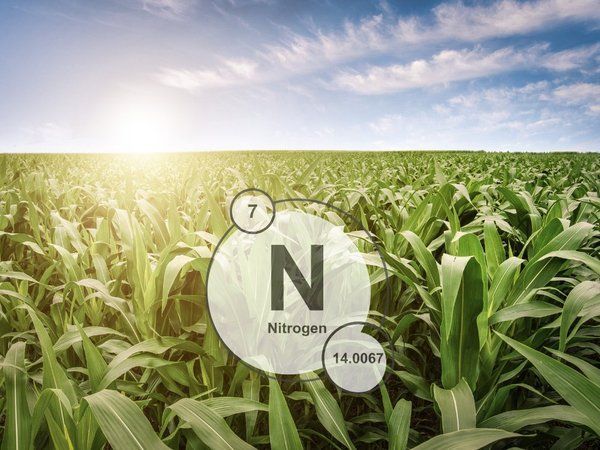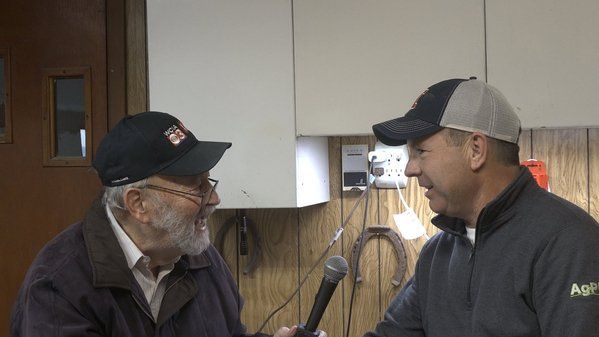Featured Article

December 24, 2024
We’re thrilled to welcome Clint as an At-Large Board Director for IL Corn Growers Association. A "skip generation" farmer, Clint began farming in 2019, reigniting his family’s agricultural tradition by cultivating corn, soybeans, and wheat in Southern Macon and Christian Counties. With a Bachelor of Science in Agronomy Management from Illinois State University and over a decade of experience in the seed industry, Clint combines professional expertise with hands-on farming knowledge. Outside of agriculture, he enjoys life with his wife, Ashley, and their soon-to-be one-year-old son, Beckett. We’re excited to have him on board and can’t wait to see his leadership in action.

December 23, 2024
Nitrogen fertilizer is one of the most significant input costs for farmers, yet many are applying more than necessary—and it’s cutting into their profitability. Precision Conservation Management (PCM) data collected over nine years shows that applying nitrogen above the University of Illinois’ Maximum Return to Nitrogen (MRTN) recommendation consistently reduces profitability. Since PCM began analyzing nitrogen use in 2015, the MRTN system has correctly predicted the most profitable nitrogen application rate every single year. For both high- and low-SPR soils, the most profitable rates are below 200 lbs of nitrogen per acre. If you’re applying more than 200 lbs of nitrogen per acre, it’s time to reconsider your approach. This simple adjustment impacts farm profitability in two ways: save up to $20 per acre in nitrogen fertilizer costs AND receive a nitrogen reduction incentive payment from one of PCM’s partners in exchange for the carbon credits you are generating by reducing your nitrogen fertilizer rate. That’s what we call a win-win! Farmers See the Benefits Farmers enrolled in PCM are increasingly adopting MRTN recommendations. According to a recent survey, 60% of PCM participants reported they are likely to apply nitrogen at MRTN rates based on insights provided by the program. As Stark County farmer Noah Forlines explains: “I appreciate the insights PCM provides to give me confidence to lower fertilizer rates while maintaining strong returns. It is a win-win for farmer profitability and improving water quality.” PCM data shows that nitrogen application rate is important in ANY financial climate, but in low-return years applying nitrogen in-season (pre-plant or sidedress) equally as important for maintaining profitability. Take Action in 2025 The time has come to shift the focus from maximizing yield to maximizing profitability. Higher nitrogen rates may get you a corn yield boost, but the additional costs of nitrogen fertilizer often outweigh the marginal gains in yield, leaving farmers with slimmer margins. For 2025, make it your goal to apply less than 200 lbs of nitrogen per acre. Wondering what the most profitable rate is for your farm? Enroll in PCM to get an individual farm data analysis for free. PCM’s tools and expert support will help you identify the most profitable in-field practices while improving environmental outcomes on your farm. By cutting nitrogen rates to MRTN recommendations, you can save money, protect water quality, and increase your farm’s profitability—all while earning incentive payments. It’s a small change with big benefits. Let PCM help you make it happen.

December 23, 2024
Following votes from Congress on year-end legislation, IL Corn Growers Association President Garrett Hawkins released the following statement: “Corn growers are deeply disappointed that a permanent, year-round E15 solution was not included in the end-of-year legislation package. This no-cost provision would have provided a market-driven solution to farmers experiencing low corn prices. “IL Corn is appreciative of House and Senate Agriculture leadership and other champions who worked hard to extend the farm bill and provide needed disaster and economic assistance to farm country. This assistance will help growers reeling from natural disasters and multiple years of low crop prices paired with high input costs. Without a permanent E15 solution, much greater assistance will be needed in the future.” Corn-based ethanol has 45-50 percent fewer greenhouse gas emissions than petroleum-based fuel. In Illinois, our 13 ethanol plants produce 1.84 billion gallons of ethanol annually and employ over 22,000 people, with a total economic output of $11.4 billion. *Economic ethanol impact analysis conducted for the IL Corn Growers Association by the Illinois Institute for Rural Affairs at Western Illinois University – Macomb Campus – March 2024

December 23, 2024
As 2024 comes to a close, IL Corn reflects on a year of delivering impactful stories that informed, inspired, and elevated Illinois farmers. From highlighting agriculture’s pivotal role in fueling our economy to addressing critical policy issues like the EPA’s ethanol oversight and tailpipe emissions, our top stories captured the challenges and triumphs of the farming community. These widely read stories exemplify our commitment to producing quality content, fostering media relationships, and advocating for farmers on the most pressing issues. Thank you for joining us on this journey—here’s to continuing the conversation in 2025! Agriculture Fuels Illinois Economy New EPA Rule Ignores Ethanol What Trump's Win Means for Ag What Farmers Need to Know Before Applying Anhydrous Ammonia Policymakers Must Take a Broader Approach To Reducing Tailpipe Emissions IL Corn Top 3 Game Plans to Drive Demand A Farmers Guide to the GREET Model Illinois FFA Water Testing Challenge Winners Announced Key Points of Ag Census Q and A with Evan Marr 6 Farmers Share Cover Crop Tips 8 Farmers Share Best and Worst Decisions Illinois Farm Families to be Featured in Super Bowl Trump and Tariffs: Where are we headed with Canada and Mexico What is the Farm Bill IL Corn Announces Scholarship Recipients Risk and Reward Equation Out of Balance ICGA Elects New Officer Board Members Boost 2024 Crop Year Revenue with PCM Megan Dwyer Appointed to EPA Committee

December 20, 2024
BLOOMINGTON, Ill. – The dispute settlement panel initiated and conducted via the terms of the U.S.-Mexico-Canada Agreement (USMCA) has ruled that Mexico violated the conditions of the agreement with a decree to ban genetically modified corn imports. The decision is a positive one for Illinois corn farmers. IL Corn Growers Association (ICGA) President and Waterloo farmer Garrett Hawkins said: “The panel’s decision affirms ICGA’s position that Mexico is not abiding by the terms of the USMCA. It's good news for Illinois corn farmers and Mexican corn importers. As the largest corn export state in the union, Illinois corn farmers are proponents of free trade agreements and of making free trade agreements work. ICGA and the National Corn Growers Association had a significant role in fighting this unscientific Mexican government overreach and urging the U.S. Trade Representative to challenge the ban that would limit Mexican buyers’ choices and reduce U.S. market access. We are so happy to see the ruling issued in our favor and look forward to building our trade relationship with our top export customer for all types of corn.” Mexico is the largest importer of U.S. corn, both yellow and white. The U.S.–Mexico–Canada Agreement (USMCA) was ratified and entered into action on July 1, 2020. President Lopez Obrador signed a decree eliminating the use of glyphosate and genetically engineered corn for human consumption on December 31, 2020. On February 13, 2023, Mexico published a modified decree. The USTR requested a dispute settlement panel challenging the measures on August 17, 2023. ### About the IL Corn Growers Association Illinois Corn Growers Association is a state-based organization that represents the interests of corn farmers in Illinois, maintaining a high profile on issues in Washington, DC, and Springfield, IL. Through grassroots advocacy, ICGA creates a future for Illinois farmers in which they can operate freely, responsibly, and successfully. In order to fulfill this mission, the organization conducts governmental affairs activities at all levels, market development projects, and educational and member service programs. For further information regarding their work and involvement, visit their website www.ilcorn.org.

December 19, 2024
Last night, the Senate passed the Water Resources Development Act (WRDA) of 2024, following its earlier passage by the House of Representatives on Monday, December 9. The bill garnered overwhelming bipartisan support, with 97 senators voting in favor and only one senator opposing the legislation. The final WRDA 2024 bill includes a pivotal provision, which permanently adjusts the inland waterways cost-share formula for construction and major rehabilitation projects. The new ratio—75% general revenues and 25% Inland Waterways Trust Fund (IWTF)—replaces the previous 65%/35% split. This change is a significant win for the future of inland waterways infrastructure. The adjustment unlocks an estimated $1.4 billion in additional funding over the next decade for Energy & Water Development appropriations that support the U.S. Army Corps of Engineers. Specifically, with annual IWTF revenues averaging $115 million, the 75%/25% cost-share increases available appropriations to $460 million—a $131 million boost compared to the previous formula. “This is a big win for Illinois farmers,” said Garrett Hawkins, Illinois farmer and ICGA President. “It allows Illinois farmers to remain competitive in the global marketplace.” IL Corn has invested decades of effort into advocating for legislation like WRDA, collaborating with partners such as WCI and numerous legislators. Adjustments to cost-share formulas have a profound impact, as they enable a larger percentage of funding to be directed toward completing critical infrastructure projects that directly benefit the agricultural economy. Illinois farmers should take pride in this milestone achievement, which reinforces their role as leaders in global agricultural trade and demonstrates the power of persistent advocacy.

December 19, 2024
In this episode, we’re talking with Troy Upoff of Findlay, Illinois, who’s once again proven he’s a powerhouse in corn production. As a two-time national winner and four-time Illinois champion in the National Corn Growers Association Yield Contest, Troy shares insights on his exceptional 2024 harvest of 385.88 bushels per acre. From selecting the right hybrid to staying ahead with innovative agronomic practices, Troy discusses his winning strategies and what’s next in his pursuit of even higher yields.
Articles
2025
2024
2023
2022
2021
2020


